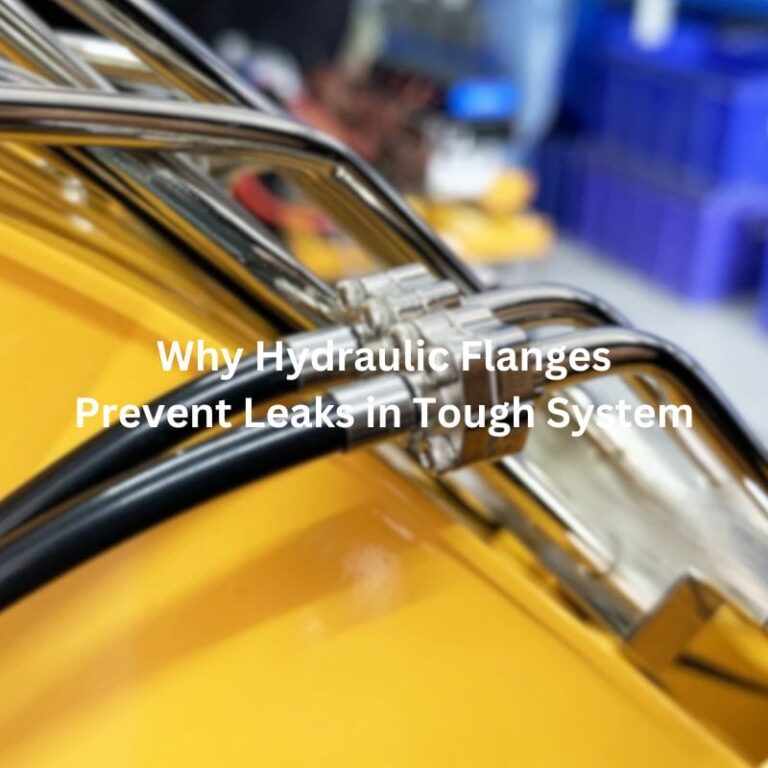What are Flange Plugs: Installation & Maintenance Tips
Introduction
In the world of industrial equipment and machinery, flange plug caps, while not as visible as other components, are essential in a variety of industries, from plumbing to heavy machinery. Their primary function is to securely close flanges, a method of connecting pipes, valves, pumps, and other equipment to form piping systems. They are designed to ensure that the connection is not only airtight but also secure and leak-proof. The purpose of this article is to take an in-depth look at the installation and maintenance of flange plugs to ensure their longevity and reliability.
Understanding Flange Plug
Definition and Basic Function
In the world of industrial equipment, flange plug caps, play a critical role, albeit often out of the limelight. Essentially, these are components used to cap off or block pipe ends in a system, ensuring no unwanted escape of materials. This function is not only about stopping flow but also about maintaining pressure and preserving the integrity of the system. Flange hydraulic plugs are particularly crucial in high-pressure environments where the secure containment of gases or liquids is paramount. They fit snugly into the flange, a flat rim or collar typically at the end of a pipe, providing a tight and secure closure. This is vital for preventing leaks and ensuring the safety and efficiency of the entire system.
Types of Flange Plug Caps
Diving deeper into the types of flange plug caps,, it becomes clear that diversity is key. The variety in materials and designs is extensive, catering to a broad spectrum of industrial needs. Materials range from robust metals like steel, known for its strength and durability, to versatile plastics, chosen for their resistance to corrosion and chemicals. The choice between a metal and a plastic flange plug, for example, hinges on factors like the type of fluid being transported, the environmental conditions, and the pressure requirements of the system. Besides material, the design also varies, with some plugs intended for temporary use during maintenance, while others are permanent fixtures. This variety allows for tailored solutions, ensuring that each system gets the specific type of flange plug it requires for optimal performance.
Advantages of Using Plugs
Benefits in Plumbing and Piping
Flange hydraulic plugs, while seemingly modest in their appearance, significantly boost the efficiency and reliability of plumbing and piping systems. Their primary role is to provide a secure and leak-proof seal, a critical function in systems that transport fluids under varying pressures. This sealing capability is essential, not only for maintaining the desired pressure within the system but also for ensuring the safety and integrity of the entire setup. The strength and durability of flange plug caps, make them a cost-effective solution. By offering a long-term sealing option, they reduce the frequency of maintenance and replacement, leading to cost savings and reduced operational downtime. In high-pressure environments, the robustness of flange plug caps, becomes even more apparent, as they can withstand intense pressure without succumbing to wear and tear, thus maintaining system integrity and reducing the risk of costly failures.
Environmental and Safety Benefits
The environmental and safety advantages of using flange plug caps, are equally significant. In terms of environmental protection, these plugs play a pivotal role. They prevent the accidental release of substances, which could be harmful to the environment. This is particularly crucial in industries dealing with hazardous materials, where leaks or spills could have severe environmental repercussions. From a safety perspective, flange pipe plugs contribute to creating a safer workplace. By preventing leaks and spills, they minimize the risk of accidents and potential hazards that could endanger workers. This aspect is particularly vital in settings where the release of gases or liquids could pose a risk of fire, explosion, or exposure to toxic substances. The robust design of these plugs, tailored to withstand various environmental and operational conditions, further bolsters workplace safety by enhancing the reliability and resilience of industrial systems.
Installation of Flange Plug Caps
Preparation and Tools Required
Before embarking on the installation of flange plug caps,, a comprehensive preparation process and the right set of tools are imperative. Essential tools include an appropriate set of wrenches or socket sets, suitable for the specific size of the flange plug. Additionally, safety equipment like gloves and protective eyewear is non-negotiable to ensure personal safety. The selection of the correct flange plug is crucial; it must correspond to the size and material of the pipe or valve it is intended for. If the system requires, a thread sealant should be on hand to ensure a watertight seal. Prior to installation, it’s vital to conduct a thorough inspection of the system where the flange plug will be fitted. This includes ensuring the pipe or valve is completely depressurized, cleaned, and free from any residual fluids or debris. It is also essential to check the compatibility of the flange plug material with the system to prevent any chemical reactions or material degradation.

Step-by-Step Installation Guide
The installation process of a flange plug, while straightforward, requires careful attention to ensure a secure and leak-proof seal. The first step involves cleaning the flange surface thoroughly, removing any rust, debris, or remnants of previous sealants. If the plug is threaded, apply a suitable thread sealant evenly on its threads. This helps in preventing leaks and ensuring a tight fit. Carefully align the plug with the flange, ensuring that it is seated properly. Using the correct size wrench, start tightening the plug in a crisscross pattern. This method ensures even distribution of pressure and prevents potential warping or damage to the flange. It’s important not to over-tighten the plug, as this could strip the threads or crack the flange. Once the plug is securely fitted, perform a visual inspection to check for proper alignment and seal. If applicable, gently repressurize the system and check for any signs of leakage. For ongoing maintenance, it’s advisable to periodically inspect the flange plug for signs of wear or damage, ensuring the ongoing integrity of the system.
Maintenance and Troubleshooting
Regular Maintenance Tips
Regular maintenance of flange plug caps, is not just about prolonging their lifespan; it is about ensuring the ongoing efficiency and safety of the entire system they serve. Routine checks should be conducted, focusing on the physical condition of the flange plug caps,. This includes looking for any visible signs of wear and tear, such as cracks or erosion, especially in environments where they are exposed to harsh chemicals or extreme temperatures. Additionally, it’s crucial to check for any signs of leakage around the plug. If the system involves fluids or gases under high pressure, even the smallest leak can be a precursor to larger problems. Cleaning the plugs and the surrounding areas regularly is also important to prevent any build-up of debris, which can compromise the plug’s integrity. It’s recommended to follow a maintenance schedule, which can be as frequent as monthly or quarterly, depending on the usage and environmental conditions.
Common Issues and Troubleshooting
When it comes to troubleshooting common issues with flange plug caps, it’s important to first understand the typical problems that can arise. One of the most common issues is the loosening of the plug over time. This can be due to several factors, including thermal expansion, vibration, or even improper installation. If a plug becomes loose, it’s vital to re-tighten it according to the manufacturer’s specifications, ensuring not to overtighten, as this can damage the plug or the flange. Another common issue is corrosion, which can be identified by a change in color or the appearance of rust. Corroded flange plug caps, should be replaced immediately to prevent system failure. In situations where problems persist or the cause of the issue is unclear, seeking professional help is advisable. A professional can provide a comprehensive inspection and recommend appropriate solutions, ensuring the continued effectiveness and safety of the system.
Advanced Applications of Flange Plug
Flange plug caps, though small in size, play a monumental role in a variety of industrial and commercial contexts. Beyond the conventional uses in plumbing and piping, their applications extend into sectors like oil and gas, chemical processing, and even aerospace. For instance, in the oil and gas industry, flange plug caps, are integral in ensuring the safe handling and transportation of petroleum products. Their robustness and ability to withstand extreme pressures and temperatures make them indispensable in this high-stakes environment. In chemical processing plants, flange plug caps are used to maintain the integrity of reactors and storage tanks, especially those containing corrosive or reactive chemicals. These plugs prevent any potential leaks, thus averting possible hazardous situations. Similarly, in the aerospace industry, they are used in fuel and hydraulic systems of aircraft, ensuring the reliability and safety of these critical systems.
The Economic Impact of Flange Plug
Cost-Efficiency Analysis
Understanding the cost-efficiency of flange hydraulic plugs requires a thorough analysis of their economic impact compared to other sealing solutions. Flange hydraulic plugs stand out for their cost-saving potential, particularly when evaluated over the long term. The initial investment in flange hydraulic plugs is generally moderate, and when this is juxtaposed with the longevity and durability they offer, the cost benefits become clear. They require less frequent replacement and maintenance, which translates to lower ongoing costs. This aspect is crucial in large-scale operations where the costs of downtime and maintenance can quickly escalate. The reliability of flange plugs in providing a secure seal also means a reduced likelihood of system failures and subsequent financial losses, making them a financially prudent choice in the long run.
Impact on Business Operations
The role of hydraulic plugs in enhancing the efficiency and productivity of business operations is significant. Their robust design and reliable performance ensure that systems operate smoothly, reducing the frequency and duration of downtimes. This is particularly important in industries where continuous operation is key to profitability. The dependability of hydraulic plugs in maintaining the integrity of systems means that businesses can avoid costly interruptions caused by system failures or leaks. Additionally, the simplicity of their installation and maintenance means that they do not require specialized skills, further reducing operational costs. The economic impact of these factors is substantial, contributing positively to the overall financial health of businesses that rely on efficient and uninterrupted system operations.
Conclusion
In this comprehensive look at flange plug caps, we delve into their basic nature, various applications, and the key role they play in different industrial environments. We also cover the key aspects of installation, maintenance, and the significant economic impact that these small but mighty components have on business operations. In addition, we address the legal and compliance aspects that are integral to the use of these devices. In conclusion, we make it clear that the proper understanding, installation, and maintenance of flange plug caps is critical to the safety, efficiency, and legal compliance of any operation.
FAQ
What is a flange plug?
A flange plug is a component used to seal or close off the end of a flanged pipe or fitting, preventing fluid or gas flow.
What materials are flange plug caps made from?
Flange hydraulic plugs are commonly made from materials like carbon steel, stainless steel, aluminum, and plastic, depending on the application requirements.
Can hydraulic plugs handle high-pressure applications?
Yes, hydraulic plugs designed for high-pressure applications are available, typically made from robust materials and designed to withstand significant pressure levels.
What are the common types of flange plugs?
Common types include blind plugs, threaded hydraulic plugs, and slip-on plugs, each suited for different sealing needs and installation methods.
How to install a flange plug properly?
To install a flange plug, align it with the flanged opening, insert bolts, and tighten evenly in a crisscross pattern to ensure a secure and leak-free seal.
What are the maintenance tips for flange plug?
Regularly inspect for signs of wear or corrosion, ensure bolts are tightened to the correct torque, and replace seals or gaskets as needed to maintain integrity.
How do I select the correct flange plug size?
Select the flange plug size based on the nominal pipe size (NPS) and flange rating, ensuring compatibility with the flanged connection.
Are flange plug caps reusable?
Depending on the material and condition, many flange fitting plugs can be reused after inspection and proper cleaning, though seals or gaskets may need replacement.

















